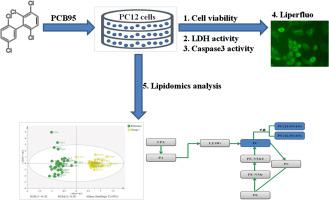当前位置:
X-MOL 学术
›
Comp. Biochem. Physiol. C Toxicol. Pharmacol.
›
论文详情
Our official English website, www.x-mol.net, welcomes your feedback! (Note: you will need to create a separate account there.)
Perturbations in glycerophospholipid levels of PC12 cells after exposure to PCB95 based on targeted lipidomics analysis.
Comparative Biochemistry and Physiology C: Toxicology & Pharmacology ( IF 3.9 ) Pub Date : 2020-05-03 , DOI: 10.1016/j.cbpc.2020.108788 Xinlu Wang 1 , Yanyang Xu 1 , Qi Jia 1 , Xiao Song 1 , Lin Zhang 1 , Wei Zhang 1 , Yongzhong Qian 1 , Jing Qiu 1
Comparative Biochemistry and Physiology C: Toxicology & Pharmacology ( IF 3.9 ) Pub Date : 2020-05-03 , DOI: 10.1016/j.cbpc.2020.108788 Xinlu Wang 1 , Yanyang Xu 1 , Qi Jia 1 , Xiao Song 1 , Lin Zhang 1 , Wei Zhang 1 , Yongzhong Qian 1 , Jing Qiu 1
Affiliation

|
Polychlorinated biphenyls (PCBs) are a group of organic chlorine chemicals that can induce various adverse health effects in animals and humans. The toxicology of PCBs is a significant public health concern because of their long-term presence in the environment. Among the 209 PCB congeners, PCB95 has been reported to be neurotoxic, however, there has been limited researches on evaluating whether and how PCB95 affects cellular lipids, the most abundant components of the brain. In this study, PCB95 was found to inhibit cell proliferation at concentrations of 0.1 μM, 2 μM and 10 μM for 120 h. Additionally, there may be a shift in apoptosis to necrosis at 2 μM PCB95 exposure for 24 h. However, lipid peroxidation was found not dominant for PCB95 exposure, especially at the concentrations of 0.1 μM and 2 μM. Because of playing vital roles in cell metabolism, 20 glycerophospholipids in PC12 cells were investigated after exposure to PCB95 for 120 h. The distinctions in the orthogonal projection to latent structures-discriminant analysis (OPLS-DA) models indicated that different concentrations of PCB95 leaded to aberrant glycerophospholipid metabolism. Based on the principles of t-test P-value < 0.05, variable importance at projection (VIP) value >1 and fold change >1, PC (14:0/14:0) and PC (16:0/14:0) were screened as potential biomarkers from all the target glycerophospholipids. This study is the first time that identifies the effects of PCB95 on specific glycerophospholipids in PC12 cells, and the observed changes in glycerophospholipids provides the basis for further evaluation of PCB95-induced neurotoxicity mechanisms.
中文翻译:

基于靶向脂质组学分析,暴露于PCB95后PC12细胞的甘油磷脂水平发生扰动。
多氯联苯(PCB)是一类有机氯化学物质,可引起动物和人类各种不良健康影响。由于多氯联苯在环境中的长期存在,因此它的毒理学是一项重大的公共卫生问题。据报道,在209种PCB同源物中,PCB95具有神经毒性,但是,有关评估PCB95是否以及如何影响脑中最丰富的细胞脂质的研究很少。在这项研究中,发现PCB95在0.1μM,2μM和10μM的浓度下可抑制细胞增殖120 h。此外,在2μMPCB95暴露24 h时,凋亡可能会转变为坏死。然而,发现脂质过氧化不是PCB95暴露的主要因素,尤其是在0.1μM和2μM的浓度下。由于在细胞代谢中起着至关重要的作用,暴露于PCB95 120 h后,对PC12细胞中的20种甘油磷脂进行了研究。对潜在结构-判别分析(OPLS-DA)模型的正交投影的区别表明,不同浓度的PCB95会导致异常的甘油磷脂代谢。根据t检验P值<0.05的原理,投影(VIP)值的可变重要性(VIP)值> 1和倍数变化> 1,PC(14:0/14:0)和PC(16:0/14:0从所有目标甘油磷脂中筛选出作为潜在生物标志物的)。这项研究是第一次确定PCB95对PC12细胞中特定甘油磷脂的影响,并且观察到的甘油磷脂变化为进一步评估PCB95诱导的神经毒性机制提供了基础。暴露于PCB95 120 h后,研究了PC12细胞中的20种甘油磷脂。对潜在结构-判别分析(OPLS-DA)模型的正交投影的区别表明,不同浓度的PCB95会导致异常的甘油磷脂代谢。根据t检验P值<0.05的原理,投影(VIP)值的可变重要性(VIP)值> 1和倍数变化> 1,PC(14:0/14:0)和PC(16:0/14:0从所有目标甘油磷脂中筛选出作为潜在生物标志物的)。这项研究是第一次确定PCB95对PC12细胞中特定甘油磷脂的影响,并且观察到的甘油磷脂变化为进一步评估PCB95诱导的神经毒性机制提供了基础。暴露于PCB95 120 h后,研究了PC12细胞中的20种甘油磷脂。对潜在结构-判别分析(OPLS-DA)模型的正交投影的区别表明,不同浓度的PCB95会导致异常的甘油磷脂代谢。根据t检验P值<0.05的原理,投影(VIP)值的可变重要性(VIP)值> 1和倍数变化> 1,PC(14:0/14:0)和PC(16:0/14:0从所有目标甘油磷脂中筛选出作为潜在生物标志物的)。这项研究是第一次确定PCB95对PC12细胞中特定甘油磷脂的影响,并且观察到的甘油磷脂变化为进一步评估PCB95诱导的神经毒性机制提供了基础。对潜在结构-判别分析(OPLS-DA)模型的正交投影的区别表明,不同浓度的PCB95会导致异常的甘油磷脂代谢。根据t检验P值<0.05的原理,投影(VIP)值的可变重要性(VIP)值> 1和倍数变化> 1,PC(14:0/14:0)和PC(16:0/14:0从所有目标甘油磷脂中筛选出作为潜在生物标志物的)。这项研究是第一次确定PCB95对PC12细胞中特定甘油磷脂的影响,并且观察到的甘油磷脂变化为进一步评估PCB95诱导的神经毒性机制提供了基础。对潜在结构-判别分析(OPLS-DA)模型的正交投影的区别表明,不同浓度的PCB95会导致异常的甘油磷脂代谢。根据t检验P值<0.05的原理,投影(VIP)值的可变重要性(VIP)值> 1和倍数变化> 1,PC(14:0/14:0)和PC(16:0/14:0从所有目标甘油磷脂中筛选出作为潜在生物标志物的)。这项研究是第一次确定PCB95对PC12细胞中特定甘油磷脂的影响,并且观察到的甘油磷脂变化为进一步评估PCB95诱导的神经毒性机制提供了基础。
更新日期:2020-05-03
中文翻译:

基于靶向脂质组学分析,暴露于PCB95后PC12细胞的甘油磷脂水平发生扰动。
多氯联苯(PCB)是一类有机氯化学物质,可引起动物和人类各种不良健康影响。由于多氯联苯在环境中的长期存在,因此它的毒理学是一项重大的公共卫生问题。据报道,在209种PCB同源物中,PCB95具有神经毒性,但是,有关评估PCB95是否以及如何影响脑中最丰富的细胞脂质的研究很少。在这项研究中,发现PCB95在0.1μM,2μM和10μM的浓度下可抑制细胞增殖120 h。此外,在2μMPCB95暴露24 h时,凋亡可能会转变为坏死。然而,发现脂质过氧化不是PCB95暴露的主要因素,尤其是在0.1μM和2μM的浓度下。由于在细胞代谢中起着至关重要的作用,暴露于PCB95 120 h后,对PC12细胞中的20种甘油磷脂进行了研究。对潜在结构-判别分析(OPLS-DA)模型的正交投影的区别表明,不同浓度的PCB95会导致异常的甘油磷脂代谢。根据t检验P值<0.05的原理,投影(VIP)值的可变重要性(VIP)值> 1和倍数变化> 1,PC(14:0/14:0)和PC(16:0/14:0从所有目标甘油磷脂中筛选出作为潜在生物标志物的)。这项研究是第一次确定PCB95对PC12细胞中特定甘油磷脂的影响,并且观察到的甘油磷脂变化为进一步评估PCB95诱导的神经毒性机制提供了基础。暴露于PCB95 120 h后,研究了PC12细胞中的20种甘油磷脂。对潜在结构-判别分析(OPLS-DA)模型的正交投影的区别表明,不同浓度的PCB95会导致异常的甘油磷脂代谢。根据t检验P值<0.05的原理,投影(VIP)值的可变重要性(VIP)值> 1和倍数变化> 1,PC(14:0/14:0)和PC(16:0/14:0从所有目标甘油磷脂中筛选出作为潜在生物标志物的)。这项研究是第一次确定PCB95对PC12细胞中特定甘油磷脂的影响,并且观察到的甘油磷脂变化为进一步评估PCB95诱导的神经毒性机制提供了基础。暴露于PCB95 120 h后,研究了PC12细胞中的20种甘油磷脂。对潜在结构-判别分析(OPLS-DA)模型的正交投影的区别表明,不同浓度的PCB95会导致异常的甘油磷脂代谢。根据t检验P值<0.05的原理,投影(VIP)值的可变重要性(VIP)值> 1和倍数变化> 1,PC(14:0/14:0)和PC(16:0/14:0从所有目标甘油磷脂中筛选出作为潜在生物标志物的)。这项研究是第一次确定PCB95对PC12细胞中特定甘油磷脂的影响,并且观察到的甘油磷脂变化为进一步评估PCB95诱导的神经毒性机制提供了基础。对潜在结构-判别分析(OPLS-DA)模型的正交投影的区别表明,不同浓度的PCB95会导致异常的甘油磷脂代谢。根据t检验P值<0.05的原理,投影(VIP)值的可变重要性(VIP)值> 1和倍数变化> 1,PC(14:0/14:0)和PC(16:0/14:0从所有目标甘油磷脂中筛选出作为潜在生物标志物的)。这项研究是第一次确定PCB95对PC12细胞中特定甘油磷脂的影响,并且观察到的甘油磷脂变化为进一步评估PCB95诱导的神经毒性机制提供了基础。对潜在结构-判别分析(OPLS-DA)模型的正交投影的区别表明,不同浓度的PCB95会导致异常的甘油磷脂代谢。根据t检验P值<0.05的原理,投影(VIP)值的可变重要性(VIP)值> 1和倍数变化> 1,PC(14:0/14:0)和PC(16:0/14:0从所有目标甘油磷脂中筛选出作为潜在生物标志物的)。这项研究是第一次确定PCB95对PC12细胞中特定甘油磷脂的影响,并且观察到的甘油磷脂变化为进一步评估PCB95诱导的神经毒性机制提供了基础。



























 京公网安备 11010802027423号
京公网安备 11010802027423号